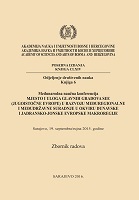DAVANJE PREDNOSTI PRVOM GRADU: KOMPARATIVNA ANALIZA ODABRANIH ZEMALJA SEE REGIONA
ATTACHING PREFERENCE TO THE FIRST CITY: COMPARATIVE ANALYSIS OF SELECTED COUNTRIES OF THE SEE REGION
Author(s): Marijana Galić, Jasmina Osmanković, Ensar Šehić
Subject(s): Regional Geography, Policy, planning, forecast and speculation, Rural and urban sociology, Economic development
Published by: Akademija Nauka i Umjetnosti Bosne i Hercegovine
Keywords: comparative analysis; planning; city data;
Summary/Abstract: This analysis is to explain the effects of urbanization processes that took place in 1990 in some countries of Southeast Europe. Namely, it is necessary to examine whether the position of capitals in emerging countries has changed in comparison to the time when these cities were the “first” cities - the largest cities and administrative centers of individual republics within Yugoslavia. The analysis will be conducted at several cross sections: 1953, 1961, 1971, 1981, 1990, 2011 and 2013, depending on the availability of data. The analysis is done in a way that the population of the first and the second city is placed in relation to the population of each of the six former republics, ie. present time states. Results obtained by extrapolation of census results made in Socialist Federative Republic of Yugoslavia in the period from 1953 to 1991, and the censuses done in 2003, 2011 and 2013, will be compared to empirical checks for some European cities and cities in developing countries (Todaro and Smith, 2006: 308), with the aim of establishing harmonization. For the purposes of this paper, analysis covered the issue of unemployment, or whether the observed cities faced the problem of urban unemployment.
- Page Range: 290-308
- Page Count: 19
- Publication Year: 2015
- Language: Bosnian
- Content File-PDF

